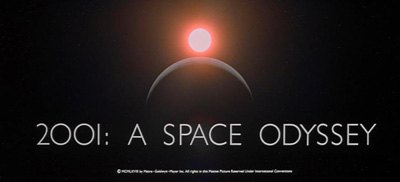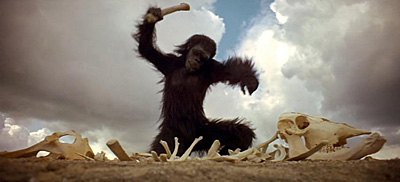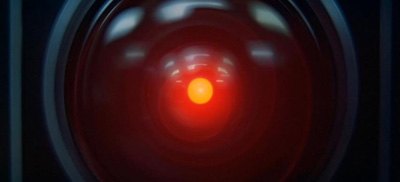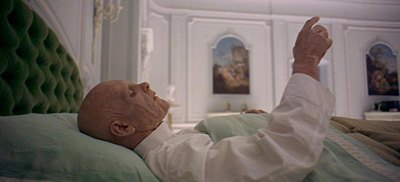| Reviews & Columns |
|
Reviews DVD TV on DVD Blu-ray 4K UHD International DVDs In Theaters Reviews by Studio Video Games Features Collector Series DVDs Easter Egg Database Interviews DVD Talk Radio Feature Articles Columns Anime Talk DVD Savant Horror DVDs The M.O.D. Squad Art House HD Talk Silent DVD
|
DVD Talk Forum |
|
|
| Resources |
|
DVD Price Search Customer Service #'s RCE Info Links |
|
Columns
|
|
|
2001 - A Space Odyssey

INTRODUCTION:
Stanley Kubrick's landmark film opens on a group of primitive man-apes fumbling about in the wilderness. A world of possibility surrounds them, but they lack the ingenuity -- or perhaps the inspiration -- to make use of the tools at their disposal. Unable to thrive in these conditions, they merely survive, lost to the most inconsequential level of existence, and even that tenuous fate remains in doubt until a mysterious black monolith arrives to usher in a new age of progress for mankind.
2001: A Space Odyssey is the cinematic equivalent of that monolith, an evolutionary leap for speculative fiction that forever changed our perception of what is possible in the medium. It challenged audiences to demand more of themselves intellectually and spiritually, and it inspired a generation of filmmakers to explore beyond convention and strive for greater heights. From a purely technical perspective, Kubrick's work elevated our expectations for detail and scientific accuracy, necessitating that he even pioneer new methods of large-scale front-projection as well as precise computerless motion control; but the greatest achievement he shared with the world was a visual and aural language of storytelling that could only be accomplished in the realm of cinema. His groundbreaking use of sight and sound reached the audience on a visceral, subconscious level that can never be approached by written or spoken word. More than just a great film, 2001 is a rare demarcation in the medium that must be noted in terms of that which came before and all that would subsequently follow as a result, and it remains quite simply one of the most important films ever made and a momentous work of art.
CONTENT:
Eschewing traditional techniques, Kubrick's odyssey immediately establishes its unique style of presentation with the musical textures of György Ligeti's "Atmosphères" building slowly against a sea of black for the first three minutes of the film. This overture is often quiet, yet overwhelming and otherworldly, implying a time before creation and preparing the viewer for the epic journey on which he is about to embark. From the darkness, heavenly bodies align in perfect symmetry and Richard Strauss's evocative tone poem "Also sprach Zarathustra" swells to envelop the space. What's immediately clear is that this isn't the beginning of a movie, but the first movement of an experience, an experience presented more with the rhythms and layers of a visual symphony than any conventional narrative storytelling structure.
Much like a symphony, 2001 is told through four movements, the first of which is titled "The Dawn of Man". Tracing back four million years into the past, Kubrick presents the first of many challenging ideas as a group of primitive man-apes are suddenly confronted with a massive black monolith that clearly is not of this world. What they lack in ingenuity they make up for in curiosity and courage, cautiously approaching the intimidating structure with a sense of wonder. Soon after, one of the man-apes starts evaluating his surroundings in a way he's never done before and slowly begins the evolutionary leap that will define the birth of mankind. Grasping the bone of an animal carcass, the pieces fall into place, and "Zarathustra" builds in the background as he recognizes the value of this object as a tool for survival and, more significantly, a weapon. Is the monolith there to witness the most important moment in human history? Or did it intentionally cause this major step in our evolution? Either way, where did it come from, and why? Arthur C. Clarke's novelization answers these questions in rather specific detail (and Kubrick himself has discussed the literal elements of this event as well), but the film wisely leaves them open to individual interpretation, subject to our own thoughts and emotions about humanity and what lies beyond. A masterful jump-cut catapults the film four million years forward, transitioning from this newly acquired bone-weapon tossed excitedly in the air to mankind's latest weaponized spacecraft orbiting about the Earth. The image is striking; the message is clear.

The latter movements of 2001 and the predominant thrust of the film take place in its own future, an 18-month period leading up to the title year. Man has advanced his tools significantly over the millennia, taking to the stars and realizing the promise of the space race that thrilled the planet in the 1960s. Kubrick's vision of the future is startlingly realistic, exhibiting a level of technical mastery that was never before approached by a filmmaker and has rarely been duplicated since. Save a few insignificant details distinct to the era and a vision of the Earth that lacks our planet's true majesty when viewed from space (Apollo 8's spectacular images were not photographed until December of 1968), 2001 captures the very essence of space travel in a way that is almost prophetic. Years of dedicated research and analysis, along with close cooperation from NASA, allowed Kubrick and Clarke to fashion a future that seems nearly as plausible today as it did some 40 years ago. Every detail is authentic, informed entirely by the physical realities and limitations of our universe, and Douglas Trumbull's intricate special effects give the presentation a life of its own. It's a good 25 minutes into the film before the first line of appropriately inconsequential dialogue is uttered, making the beautiful journey to reach this moment all the more profound, for no words could ever convey the artistry of space flight as memorably as watching the graceful craft set against the rhythmic sounds of Johann Strauss's "Blue Danube".
We join this period of time because something incredible has been discovered beneath the surface of the moon, and a spacecraft is dispatched to the stars to investigate just what it means. Aboard Discovery One is a modest crew: two humans maintaining the ship's more basic functions in overlapping shifts throughout the day, three unseen scientists preserved in suspended animation for a later leg of the journey, and a supercomputer with the latest in artificial intelligence known as the HAL 9000 (Douglas Rain). It's during this craft's mission to Jupiter that 2001 addresses its most complex themes. Our primary introduction to pilots Frank Poole (Gary Lockwood) and David Bowman (Keir Dullea) is through a television interview for the audience back home, and they are joined by their shipmate HAL, who communicates with a steady, comforting voice. What becomes evident through this interaction is the cold and almost mechanical personalities of the two astronauts. There's no sense of wonder and very little indication of any distinctly emotional response. A celebration of Poole's birthday (a recurring theme to be sure) elicits a lethargic disinterest from the lounging pilot. Is this a function of the many months of monotonous duties aboard their craft or a sign of something more? To venture out into space, man has had to relearn how to walk, he eats the relative equivalent of baby food, and even requires detailed instructions for how to use a toilet. Are we poised for the next great leap in our evolution or have we peaked, doomed to be as stagnant and insignificant as our man-ape ancestors?
HAL, on the other hand, displays great enthusiasm for his role on the ship, even a sense of pride in his value, and is without question the most "human" member of the crew. Man's greatest tool is becoming more important than man himself and may also be capable of individuality and sentience. Unlike his human counterparts, HAL notes that he is putting himself to the fullest possible use, which is in his opinion all that any conscious entity could ever hope to do. The "Jupiter Mission" section of the film is often the most remembered as it contains within it the most recognizable elements of classic storytelling, presenting an exciting battle between man and machine as HAL malfunctions to trigger a struggle for self-preservation between him and the rest of the crew. But it is also the focal point for the film's most important thematic elements, and we are forced to question the very nature of our own humanity and our place in the universe. What separates man from ape, man from machine, man from god? What is it that makes us special, and what lies beyond? Through Bowman, man's capacity is tested to great extremes, and his incredible journey dominates the second half of the film as he is pushed to the very edge of extinction by his own man-made tool; but unlike his primitive ancestors millions of years in the past, he is armed with ingenuity and creativity in addition to his courage.

There are many factors that contribute to the success of 2001, and they almost all stem from Kubrick's meticulous obsession with getting every last detail absolutely perfect, from the physical elements of the set to the emotional resonance of the themes. Inspired by numerous works of literature and philosophy, not the least of which are Homer's epic poem and Friedrich Nietzsche's writings on man as the embarrassing bridge between ape and the Übermensch (or overman/superman), 2001 weaves layer upon layer of symbolism and meaning into an incredible tapestry of visual poetry that is presented like a magnificent symphony. The inventive use of sound and music are equally mesmerizing, from the brilliant selection of classical compositions to the haunting accompaniment for the monolith's appearance to the inspired use of no music at all, only the sounds of an astronaut anxiously breathing alone in the void of space. 2001: A Space Odyssey is a rousing science fiction adventure, a thought-provoking window into the human condition, a sensory feast of audiovisual experience, and a visceral union of man's ability to conquer the impossible while failing to comprehend the unknowable. It is a masterwork.
PRESENTATION:
2001 arrives on Blu-ray in spectacular fashion. Previous home releases of the film are dwarfed by the level of quality and detail present on this disc. The 1080p VC-1 transfer is a revelation, and the detail revealed throughout the 2.20:1 presentation is absolutely stunning. The facial features of Bowman and Poole are striking, with every intricate detail of the wardrobes and instrument panels and models available like never before. Skin tones are spot on, black levels are fantastic (absolutely essential for this film), and the colors are rich and full, particularly in the early "Dawn of Man" scenes where previous releases were dull and muddy. The features in the clouds have returned, and the man-apes are black once more (not to mention the monolith!). To create these sequences for the first movement of the film, Kubrick re-engineered a front-projection technique to allow for large-scale scenic backgrounds to be used on a stage set. This was accomplished by rolling a special lenticular material designed by 3M onto giant screens behind the action such that an image could be indirectly projected onto the screen and reflected back to the camera on a massive scale. If there's a "flaw" in this release, it's that the detail is so superb you can easily detect the reflectivity variations in the lenticular mosaic.
Audio is offered in English in both uncompressed PCM 5.1 as well as Dolby Digital 5.1. French, Spanish, German, and Italian tracks are also available in DD 5.1. The soundtrack presented here is incredibly strong, especially in the uncompressed mix. Dialogue is clean and perfectly balanced, and the surround channels are used effectively, although some may find the mix a little heavy on the front channels. The soundtrack really shines in the latter stages of the film when audio is confined to Dave's breathing or the sounds of the EVA pod, as well as the ambient noises Bowman experiences beyond the infinite. When the score swells in the most epic moments, the mix envelops the soundstage to glorious effect. I've waited a long time for a truly great home media release of this film, and Warner has completely delivered with this product.
The menu structure is coherent and easy to navigate. Subtitles exist in English, French, Spanish, Chinese, Danish, Dutch, Finnish, German, Italian, Korean, Norwegian, Portuguese, and Swedish. Many of the standard definition bonus features are subtitled as well.

WHISTLES & BELLS:
This Blu-ray release of 2001 isn't technically a "special edition", but it may as well be. The bonus material here is wonderful.
- Commentary by Keir Dullea and Gary Lockwood
The actors behind Dave Bowman and Frank Poole reminisce about how they got involved with the project what it was like to work with such a visionary director, and they share their personal opinions about the greater meanings in the film. There's a pretty good balance of personal stories and behind-the-scenes information such that the commentary never becomes dull. Often commentaries aren't really worth your time, but this is a good one.
- 2001: The Making of a Myth (43:08)
James Cameron "hosts" this informative documentary about the film. Cameron introduces the piece, rather poorly in fact, but most of it is driven by the interview comments of those who worked on the film as well as those who have spent a lifetime analyzing it. While there are some awkward reenactments of various scenes, and the arrangement used for Richard Strauss' incredible music is very lacking, the piece is still incredibly informative.
- Standing on the Shoulders of Kubrick: The Legacy of 2001 (21:25)
It's almost impossible to overstate the influence 2001 had on an entire generation of filmmakers, and this featurette focuses on the effect it had on the likes of Steven Spielberg, Sydney Pollack, George Lucas, Ben Burtt, William Friedkin and a whole host of directors and visual effects specialists. This piece is more technical in nature than the previous one and also showcases a better production value.
- Vision of a Future Passed: The Prophecy of 2001 (21:31)
A companion piece to "Standing on the Shoulders", this featurette examines the accuracy of the futuristic elements used in the film and discuses the predictive nature of its vision, not just in terms of the technology we use today but also the way in which we interact with it as humans.
- 2001: A Space Odyssey -- A Look Behind the Future (23:11)
This is a nostalgic promotional piece from ages past developed by "Look" magazine. The quality of the video is poor, but the behind-the-scenes details provided by technical advisor Fred Ordway and aeronautics specialist Harry Lange in the early stages of the project are quite informative.
- What is Out There? (20:42)
Keir Dullea narrates a segment that starts off rather awkward with him reading from notes on his lap but evolves into another informative look at the themes presented in the film. Excerpts from an interview with Arthur C. Clarke are sourced as well as Dullea sharing relevant quotes from great thinkers like Isaac Asimov. The piece is written, rather well I should note, by Anthony Frewin, son of the film's unit production manager and a longtime assistant to Stanley Kubrick.
- 2001: FX and Early Conceptual Artwork (9:27)
The first half of this features visual effects supervisor Doug Trumball discussing the slit-scan techniques used during the final voyage beyond the infinite as well as the method of dabbing lacquer and enamel paints in water to create the illusion of shattering cosmic events. Christiane Kubrick follows with an introduction to the conceptual artwork everyone associated with the project was asked to submit to help guide the direction of the film's final act. None of it was used, but it's worth a look.
- Look: Stanley Kubrick! (3:15)
This is a wonderful collection of 1940's photography from Kubrick's time working for "Look" magazine. His talent is obvious even here.
- 11/27/1966 Interview with Stanley Kubrick (1:16:30)
Perhaps the best inclusion on the set, this 75-minute interview with physicist and author Jeremy Bernstein is a candid discussion from the formative years of a visionary artist. There is an incredible wealth of information here, and anyone who considers himself a fan of Kubrick's work is sure to enjoy it. Thankfully, there are chapter skips in 5-minute increments, so it's easy to return to later if you don't want to invest all that time in one sitting.
- Theatrical Trailer

CONCLUDING THOUGHTS:
2001: A Space Odyssey is a masterpiece, the magnum opus of our greatest filmmaker and one of the most important films ever made. It advanced the art in innumerable ways, and it inspired a generation of filmmakers to push the limits of what is possible. From a purely technical perspective, it is a marvel of special effects precision and scientific authenticity, and its use of musical composition has no equal. The numerous thematic layers force us to ponder life's greatest mysteries, and we cannot help but question the very nature of our own humanity. Stanley Kubrick has been quoted that, "sometimes the truth of a thing is not so much in the think of it, but in the feel of it." In his finest film, he conquers both, clashing man's great capacity with his ultimate limitation in way that resonates both intellectually and emotionally. Owning 2001 on any format is a virtual necessity, but when it's presented with such incredible audio and video fidelity and accompanied by a wonderful array of bonus features, the recommendation becomes a no-brainer: DVD Talk Collector Series.
N.B.: Images in this review exist to look pretty and are in no way representative of the quality of the high definition transfer
|
| Popular Reviews |
| Sponsored Links |
|
|
| Sponsored Links |
|
|
| Release List | Reviews | Shop | Newsletter | Forum | DVD Giveaways | Blu-Ray | Advertise |
|
Copyright 2024 DVDTalk.com All Rights Reserved. Legal Info, Privacy Policy, Terms of Use,
Manage Preferences,
Your Privacy Choices | |||||||












